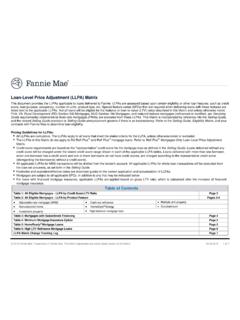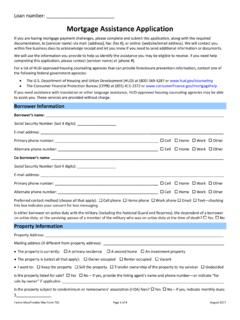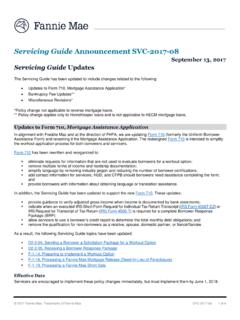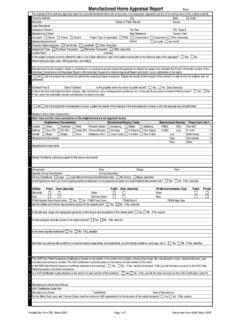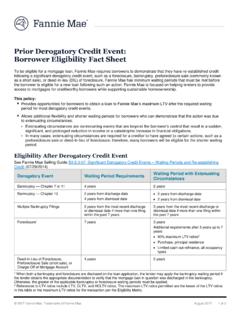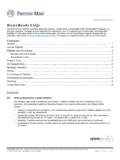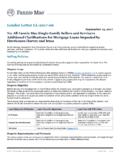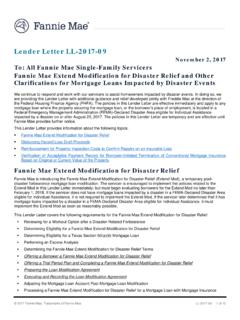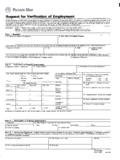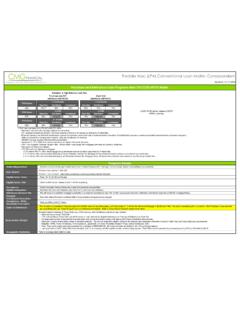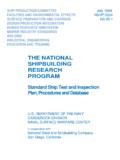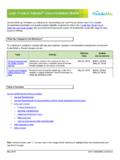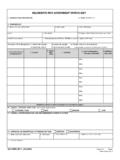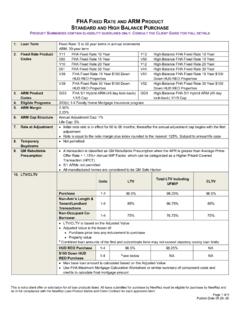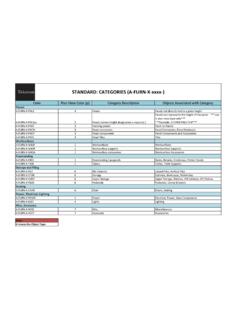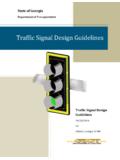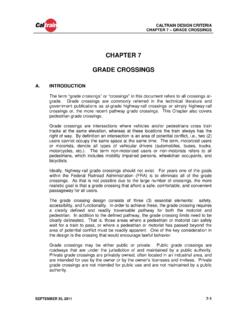Transcription of Hybrid ARM Components - Fannie Mae | Home
1 2013 Fannie Mae. Trademarks of Fannie Mae. September 2013 Page 1 of 10 Hybrid ARM Components September 2013 As primary mortgage rates have been on the rise, renewed interest in Adjustable Rate Mortgages (ARMs) has emerged. While Hybrid ARM issuance by the GSEs has been modest in recent years, mainly due to 30-year fixed rates reaching historical lows, this small sector of the mortgage market has been gaining the attention of many participants, including borrowers, lenders, and investors. The purpose of this commentary is to provide a detailed overview of Hybrid ARMs and is divided into several sections for easy reference. The first section explains the mechanics of ARM loans and what factors drive borrower preference. The next section discusses issuance volumes, pricing methodology, and hedging strategies of ARM pools. The final section summarizes current market dynamics and the fundamental impact that rising interest rates has had on the Hybrid ARM market.
2 I. ARMS 101 The Mechanics of an Adjustable Rate Mortgage An Adjustable Rate Mortgage, or an ARM is a mortgage loan where the interest rate paid by the borrower adjusts on an annual* basis. The rate adjustment depends on the index, margin, and cap structure, each of which is explained in detail below. An ARM can also be referred to as a 1-year ARM. A Hybrid ARM however, is a loan that has an initial fixed-rate period, usually for 3, 5, 7, or 10 years, after which it adjusts annually. By offering borrowers several different fixed rate periods, Hybrid ARMs are the most popular type of Adjustable Rate Mortgages. Due to their popularity, Hybrid ARMs will be the primary focus of this commentary. *While some ARMs reset semi-annually, the majority of ARM loans are issued with an annual reset period. ADJUSTMENT PERIOD The initial rate on a Hybrid ARM is fixed for a specified period.
3 For instance, on a 5/1 Hybrid ARM, the first digit, 5 refers to the initial fixed rate period, while the second digit 1 refers to the subsequent adjustment period. After 5 years, the rate on a 5/1 ARM will adjust higher or lower depending on the index and cap structure (explained below). The rate will then adjust annually for the remaining life of the loan. INDEX The index is a benchmark interest rate to which a loan s margin (see section below on margin) is added when calculating the new rate paid by a borrower when the Hybrid ARM loan adjusts. While there are many different benchmarks, the most common is LIBOR, or London Interbank Offered Rate. LIBOR is the interest rate at which banks can borrow funds, in large size, from other banks in the London interbank market. LIBOR is set on a daily basis by the British Bankers Association and terms range from overnight to one year.
4 The 1-year LIBOR rate is the most common index used for conventional Hybrid ARMs. 2013 Fannie Mae. Trademarks of Fannie Mae. September 2013 Page 2 of 10 MARGIN AND NET MARGIN The margin on an ARM is defined as the percentage rate that is added to the index to determine a Hybrid ARM s new interest rate at each rate adjustment (called the fully-indexed interest rate ). As mentioned above, the most widely used index is LIBOR and the most common margin on a Hybrid ARM indexed to LIBOR is Therefore, when a Hybrid ARM s rate adjusts, the new rate is calculated by adding the margin ( ) to the index rate (1-year LIBOR) and rounding to the nearest 1/8th percent. This new rate (subject to caps see section below) remains on the loan until the next reset. Net margin is important to investors and is used when ARM loans are pooled into Agency MBS securities.
5 When pools are created, both a guaranty fee charged by the GSE and servicing fee charged by the servicer must be subtracted from the margin. The remaining net margin is added to the benchmark index rate (1-year LIBOR), which determines the coupon rate that is passed through to the investor of the MBS pool. CAP STRUCTURE The interest rate cap structure identifies the maximum amount by which a loan s rate can adjust, up or down. There are three parts to a typical cap structure: the initial adjustment cap, the periodic adjustment cap and the lifetime adjustment cap. The initial adjustment cap is the maximum amount by which the rate can be adjusted (up or down) at its first adjustment at the end of its initial fixed period. The periodic adjustment cap is the maximum amount by which the rate can be adjusted at the end of each subsequent period following the initial fixed period.
6 Finally, the lifetime cap is the maximum amount by which the rate can be adjusted over the entire life of the loan. The most common cap structures on Hybrid ARMs are 2/2/6, 2/2/5 and 5/2/5. The 2/2/6 cap structure is most commonly seen on the 3/1 Hybrid ARM product. 2/2/5 and 5/2/5 are common on the 5/1 Hybrid ARM product. Lastly, 7/1 and 10/1 Hybrid products generally have 5/2/5 cap structures. NOTE: Please refer to the outline distributed on 8/13/2013 which describes the difference between 2/2/5 and 5/2/5 cap structures, specifically for 5/1 Hybrid ARMs. FLOOR The interest rate floor on an ARM is simply defined as the lowest rate to which the interest rate can adjust at any point during the life of the loan. Most Fannie Mae ARM plans do not have an explicit floor, but the interest rate cannot decline below its stated margin. The most common margin value for 1-year LIBOR indexed ARMs is Therefore, the borrower s rate could not adjust any lower than For easy reference, please refer to the Fannie Mae Standard ARM plan matrix here: Fannie Mae ARM matrix LOOKBACK PERIOD The lookback period identifies the number of calendar days the servicer looks back from the ARM s reset date to calculate the new interest rate on the loan.
7 The most common lookback period on Fannie Mae ARMs is 45 days. Therefore, if the reset date is September 1, the servicer would use the index value from July 18th to calculate the new rate and payment on the loan. OVERVIEW CONCLUDED: EXAMPLE Now that the definitions of index, cap structure, floor, margin, and lookback have been provided, an example is shown below to show the mechanics of each component . Assumptions: Product: 5/1 ARM Index: 1-year LIBOR Initial Fixed Rate: Cap Structure: 2/2/5 2013 Fannie Mae. Trademarks of Fannie Mae. September 2013 Page 3 of 10 Margin: Floor: Lookback Period: 45 days First Adjustment Date: 9/1/2013 First Payment Date: 9/1/2008 In this example, the loan s rate is for the first 5 years until the first adjustment on September 1. The initial adjustment cap of 2% means that at the first adjustment at the end of the 5-year initial fixed rate period, the rate could adjust as high as or as low as , which is the floor.
8 The periodic adjustment cap is also 2%, so if the rate adjusted to at the first adjustment, it could adjust to a maximum of and a minimum of at the next adjustment a year later. The lifetime adjustment cap is , so the maximum the rate could reach in our example is (initial rate + lifetime cap). In order to calculate what the rate will adjust to on September 1, the servicer looks back 45 days from the adjustment date, which is July 18. On July 18, the 1-year LIBOR value was Finally, the margin is added to the index value to get ( + ). The calculated rate is then rounded to the nearest 1/8th, so the new adjusted rate to the borrower becomes on September 1. For guidance on specific ARM plans, please refer to section of the Fannie Mae Selling Guide. II. Drivers of Renewed Interest in Hybrid ARMs & Borrower Profile Renewed Interest STEEP YIELD CURVE The US Treasury curve is commonly referred to as the yield curve.
9 When measuring the steepness of the treasury or yield curve, one would take the difference between the 10yr UST note yield and the 2yr UST note yield. On August 1, 2013, the 10yr yield was ~ while the 2yr yield was ~ Therefore, the curve was or 238 bps steep ( - .33% = ). On January 2 of this year, the 10yr yield was vs a 2yr yield of , leaving the curve 158 bps steep. Obviously, the curve has steepened since the beginning of the year. In general, the steeper the curve, the more ARM origination picks up. Why? 30-year mortgages are more correlated with the longer end of the yield curve ( the 7-year or longer part of the curve). In contrast, given that most Hybrid ARMs are indexed to the 1-year Treasury or 1-year LIBOR rates and they adjust for the first time in 3 to 10 years (3/1, 5/1s, 7/1s, and 10/1s are the most common), they are usually more correlated with the shorter end of the curve.
10 The steeper the curve, the larger the difference between long term and short term rates which usually translates into a larger difference between 30-year mortgage rates and Hybrid ARM rates. The larger the difference between the two, the more likely a borrower will opt for a Hybrid ARM as opposed to a 30-year fixed rate loan. DIFFERENCE IN RATE VS 30YR FIXED RATE PRODUCT Historically, borrowers tended to prefer Hybrid ARMs when the rate differential between the Hybrid ARM product and a 30-year fixed rate loan was ~ (100 bps) or greater. However, at the beginning of the year, the rate differential was closer to 125 150 bps, but Hybrid ARM production remained limited. Why? Presumably because the absolute rate on the 30-year fixed rate loan was hovering in the - range. Borrowers may have preferred to lock in a fixed rate for 30 years at historical lows vs.
